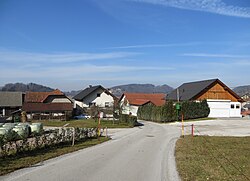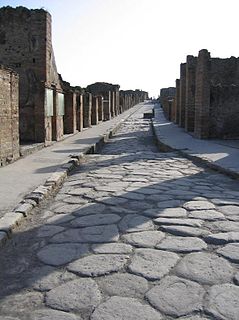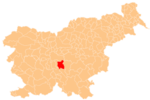
Grosuplje is a town in central Slovenia. It is the seat of the Municipality of Grosuplje. It lies just south of the capital Ljubljana in the traditional region of Lower Carniola. It is now included in the Central Slovenia Statistical Region.

Zgornje Škofije is a village in the City Municipality of Koper in the Littoral region of Slovenia. The settlement is made up of the hamlets of Druga Škofija, Tretja Škofija, Četrta Škofija, and Rombi, in increasing elevation.

Tlake is a settlement in the Municipality of Rogatec in eastern Slovenia. The area traditionally belonged to the Styria region. It is now included in the Savinja Statistical Region.

Spodnje Gameljne is a village on the right bank of the Sava River north of the capital Ljubljana in central Slovenia. It belongs to the City Municipality of Ljubljana. It was part of the traditional region of Upper Carniola and is now included with the rest of the municipality in the Central Slovenia Statistical Region.

Srednje Gameljne lies north of the capital Ljubljana in central Slovenia. It belongs to the City Municipality of Ljubljana. It was part of the traditional region of Upper Carniola and is now included with the rest of the municipality in the Central Slovenia Statistical Region.
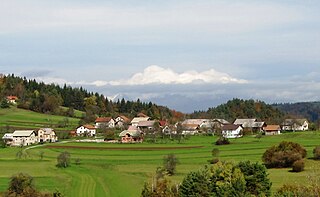
Veliki Lipoglav is a small settlement in the hills southeast of Ljubljana in central Slovenia. It belongs to the City Municipality of Ljubljana and is part of the traditional region of Lower Carniola. It is now included with the rest of the municipality in the Central Slovenia Statistical Region.

Tlaka is a settlement south of Gabrovka in the Municipality of Litija in central Slovenia. Traditionally the area was part of Lower Carniola and is now included with the rest of the municipality in the Central Sava Statistical Region.

Čolnišče is a settlement west of Zagorje ob Savi in central Slovenia. The area is part of the traditional region of Upper Carniola. It is now included with the rest of the municipality in the Central Sava Statistical Region.

Močle is a village in the Municipality of Šmarje pri Jelšah in eastern Slovenia. It lies in the hills west of Šmarje. The area is part of the historical Styria region. The municipality is now included in the Savinja Statistical Region. It is a clustered village on the south side of a gentle slope. It includes the hamlets of Erpoge and Sveti Lovrenc.

Cikava is a small settlement in the Municipality of Grosuplje in central Slovenia. It lies halfway between Grosuplje and Šmarje–Sap on the old regional road leading towards Ljubljana. The area is part of the historical region of Lower Carniola. The municipality is now included in the Central Slovenia Statistical Region.

Žalna is a settlement in the Municipality of Grosuplje in central Slovenia. It lies southeast of Grosuplje in the historical region of Lower Carniola. The municipality is now included in the Central Slovenia Statistical Region. It includes the hamlets of Prevale, Velika Žalna, and Mala Žalna, as well as part of the hamlet of Na Šoli.
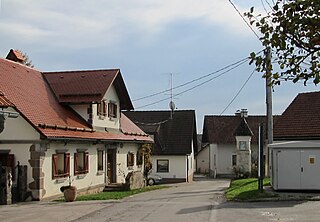
Zgornja Slivnica is a settlement in the Municipality of Grosuplje in central Slovenia. It lies in the hills north of Grosuplje and northeast of Šmarje-Sap and south of Mali Lipoglav in the historical region of Lower Carniola. The municipality is now included in the Central Slovenia Statistical Region.

Veliko Mlačevo is a village in the Municipality of Grosuplje in central Slovenia. It lies just southeast of Grosuplje itself in the historical region of Lower Carniola. The municipality is now included in the Central Slovenia Statistical Region. The settlement includes the hamlet of Boštanj south of the main settlement.

Gajniče is a small settlement just southwest of Šmarje–Sap in the Municipality of Grosuplje in central Slovenia. The entire municipality is included in the Central Slovenia Statistical Region. The area is part of the historical region of Lower Carniola.

Hrastje pri Grosupljem is a settlement between Grosuplje and Šmarje-Sap in central Slovenia. The Slovenian A2 motorway runs across the settlement's territory. The area is part of the historical region of Lower Carniola. The Municipality of Grosuplje is now included in the Central Slovenia Statistical Region.

Paradišče is a settlement just east of Šmarje–Sap in the Municipality of Grosuplje in central Slovenia. The area is part of the historical region of Lower Carniola. The municipality is now included in the Central Slovenia Statistical Region.

Podgorica pri Šmarju is a small settlement just north of Šmarje–Sap in the Municipality of Grosuplje in central Slovenia. The area is part of the historical region of Lower Carniola and is now included in the Central Slovenia Statistical Region.

Jerova Vas is a formerly independent settlement in the northern part of the town of Grosuplje in central Slovenia. It belongs to the Municipality of Grosuplje. It was part of the traditional region of Lower Carniola and is now included with the rest of the municipality in the Central Slovenia Statistical Region.

Stranska Vas is a formerly independent settlement in the northwest part of the town of Grosuplje in central Slovenia. It belongs to the Municipality of Grosuplje. It was part of the traditional region of Lower Carniola and is now included with the rest of the municipality in the Central Slovenia Statistical Region.
